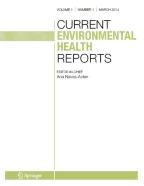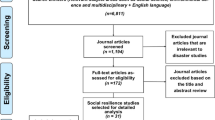A Review of the Literature on Community Resilience and Disaster Recovery

The concept of resilience continues to grow in influence and prominence in national and international programs seeking to improve individual and collective capacity to prepare for and respond to disasters. This review of the literature published in 2018 examines how disaster scholars and professionals are conceptualizing and applying the concept of community disaster resilience.
Recent Findings
Three trends in the literature on community disaster resilience are observed: (1) advancements in the measurement of resilience continue to refine the concept and its related mechanisms using both primary and secondary data, (2) social capital continues to be a central mechanism through which community resilience reduces disaster impact and enhances recovery, and (3) programs across the globe are advancing the practice of improving resilience through community interventions to enhancing adaptive capacities.
Summary
Community disaster resilience offers much promise as a guiding paradigm for the promotion of disaster risk reduction and the enabling of disaster recovery through attention to, and investment in, local capacities for adaptation to a changing and uncertain environment. However, there remains work to be done in the clarification of the concept and the operationalization of the mechanisms leading to enhancing community capacity for resilience.
This is a preview of subscription content, log in via an institution to check access.
Access this article
Subscribe and save
Springer+ Basic
€32.70 /Month
- Get 10 units per month
- Download Article/Chapter or eBook
- 1 Unit = 1 Article or 1 Chapter
- Cancel anytime
Buy Now
Price includes VAT (France)
Instant access to the full article PDF.
Rent this article via DeepDyve
Similar content being viewed by others

A temporal social resilience framework of communities to disasters in Australia
Article Open access 18 December 2018

The Community Resilience Approach to Disaster Recovery: Strategies Communities Can Use
Chapter © 2018

A Critical Review of Social Resilience Properties and Pathways in Disaster Management
Article Open access 09 November 2021
Explore related subjects
References
Papers of particular interest, published recently, have been highlighted as: • Of importance •• Of major importance
- Norris FH, Stevens SP, Pfefferbaum B, Wyche KF, Pfefferbaum RL. Community resilience as a metaphor, theory, set of capacities, and strategy for disaster readiness. Am J Community Psychol. 2008;41(1–2):127–50. https://doi.org/10.1007/s10464-007-9156-6. ArticlePubMedGoogle Scholar
- National Academies (US). Disaster resilience: a national imperative: National Academies Press; 2012. https://doi.org/10.17226/13457.
- Maini R, Clarke L, Blanchard K, Murray V. The Sendai Framework for disaster risk reduction and its indicators—where does health fit in? Int J Disaster Risk Sci. 2017;8(2):150–5. https://doi.org/10.1007/s10461-016-1662-9. ArticleGoogle Scholar
- Koliou M, van de Lindt JW, McAllister TP, Ellingwood BR, Dillard M, Cutler H. State of the research in community resilience: Progress and challenges. Sustain Resilient Infrastruct. 2017;1–21. https://doi.org/10.1080/23789689.2017.1418547.
- Holling CS. Resilience and stability of ecological systems. Annu Rev Ecol Syst. 1973;41:1–23. https://doi.org/10.1146/annurev.es.04.110173.000245. ArticleGoogle Scholar
- Uekusa S. Rethinking resilience: Bourdieu’s contribution to disaster research. Resilience. 2018;6(3):181–95. https://doi.org/10.1080/21693293.2017.1308635. ArticleGoogle Scholar
- Tiernan A, Drennan L, Nalau J, Onyango E, Morrissey L, Mackey B. A review of themes in disaster resilience literature and international practice since 2012. Policy Des Pract. 2018;2:1–22. https://doi.org/10.1080/25741292.2018.1507240. ArticleGoogle Scholar
- • Matin N, Forrester J, Ensor J. What is equitable resilience? 2018:109:1970295. https://doi.org/10.1016/j.worlddev.2018.04.020. This article articulates a vision for equitable resilience as a ‘middle range’ theory that can be observed and tested alongside existing measures of resilience. Unlike many of the extant operationalizations of resilience, equitable resilience takes into greater account social vulnerabilities and differential access to power, knowledge, and resources.
- Khazai B, Anhorn J, Burton CG. Resilience performance scorecard: measuring urban disaster resilience at multiple levels of geography with case study application to Lalitpur, Nepal. Int J Disaster Risk Reduct. 2018;31:604–16. https://doi.org/10.1016/j.ijdrr.2018.06.012. ArticleGoogle Scholar
- Rus K, Kilar V, Koren D. Resilience assessment of complex urban systems to natural disasters: a new literature review. Int J Disaster Risk Reduct. 2018;31:311–30. https://doi.org/10.1016/j.ijdrr.2018.05.015. ArticleGoogle Scholar
- Abenayake CC, Mikami Y, Matsuda Y, Jayasinghe A. Ecosystem services-based composite indicator for assessing community resilience to floods. Environ Dev. 2018;27:34–46. https://doi.org/10.1016/j.envdev.2018.08.002. ArticleGoogle Scholar
- Summers JK, Harwell LC, Smith LM, Buck KD. Measuring community resilience to natural hazards: the Natural Hazard Resilience Screening Index (NaHRSI)—development and application to the United States. GeoHealth. 2018;2(12):372–94. https://doi.org/10.1029/2018GH000160. ArticleGoogle Scholar
- Saja AA, Teo M, Goonetilleke A, Ziyath AM. An inclusive and adaptive framework for measuring social resilience to disasters. Int J Disaster Risk Reduct. 2018;28:862–73. https://doi.org/10.1016/j.ijdrr.2018.02.004. ArticleGoogle Scholar
- Jones L, Samman E, Vinck P. Subjective measures of household resilience to climate variability and change: insights from a nationally representative survey of Tanzania. Ecol Soc. 2018;23:1–9. https://doi.org/10.5751/ES-09840-230109. ArticleGoogle Scholar
- Kwok AH, Paton D, Becker J, Hudson-Doyle EE, Johnston D. A bottom-up approach to developing a neighbourhood-based resilience measurement framework. Disaster Prev Manag Int J. 2018;27(2):255–70. https://doi.org/10.1108/DPM-07-2017-0169. ArticleGoogle Scholar
- Chuang WC, Garmestani A, Eason TN, Spanbauer TL, Fried-Petersen HB, Roberts CP, et al. Enhancing quantitative approaches for assessing community resilience. J Environ Manag. 2018;213:353–62. https://doi.org/10.1016/j.jenvman.2018.01.083. ArticleCASGoogle Scholar
- • Serfilippi E, Ramnath G. Resilience measurement and conceptual frameworks: a review of the literature. Ann Public Coop Econ. 2018;89(4):645–64. https://doi.org/10.1111/apce.12202. This article examines an extensive set of resilience concepts and indicators, linking each model of resilience to an application and set of indicators – bridging the diversity in various definitions and operationalizations that exist in the literature.
- United Nations Office for Disaster Risk Reduction (UNISDR). 2009 UNISDR terminology on disaster risk reduction. 2009. Geneva. http:www.unisdr.org/we/inform/terminology. Accessed 28 June 2019.
- United States Agency for International Development. Building resilience to recurrent crisis. USAID policy and programe guidance. 2012. https://www.usaid.gov/sites/default/files/documents/1870/USAIDResiliencePolicyGuidanceDocument.pdf. Accessed 28 June 2019.
- Food and Agriculture Organization of the United Nations. FAO in emergencies. 2019. http://www.fao.org/emergencies/how-we-work/resilience/en/. Accessed 28 June 2019.
- NYU Marron Institute. 100 RC handbook: planning for resilient urban growth. 2018. NYU Marron Institute of Urban Management in collaboration with 100 Resilient Cities. https://www.100resilientcities.org/wp-content/uploads/2018/09/NYU-Urban-Growth-Handbook_FINAL.pdf. Accessed 28 June 2019.
- Cai H, Lam NS, Qiang Y, Zou L, Correll RM, Mihunov V. A synthesis of disaster resilience measurement methods and indices. Int J Disaster Risk Reduct. 2018;31:844–55. https://doi.org/10.1016/j.ijdrr.2018.07.015. ArticleGoogle Scholar
- •• Horney J, Dwyer C, Chirra B, McCarthy K, Shafer J, Smith G. Measuring successful disaster recovery. Int J Mass Emerg Disasters. 2018;36(1):1–22. https://doi.org/10.1111/disa.12190. This article considers a substantial set of 79 publically available disaster recovery metrics. These metrics can improve how we assess resilience as an outcome by supporting proactive recovery planning.
- Zou L, Lam NS, Cai H, Qiang Y. Mining Twitter data for improved understanding of disaster resilience. Ann Am Assoc Geogr. 2018;108(5):1422–41. https://doi.org/10.1080/24694452.2017.1421897. ArticleGoogle Scholar
- Kontokosta CE, Malik A. The resilience to emergencies and disasters index: applying big data to benchmark and validate neighborhood resilience capacity. Sustain Cities Soc. 2018;36:272–85. https://doi.org/10.1016/j.scs.2017.10.025. ArticleGoogle Scholar
- Zobel CW, Baghersad M, Zhang Y. An approach for quantifying the multidimensional nature of disaster resilience in the context of municipal service provision. In: Urban disaster resilience and security 2018. Cham: Springer. p. 239–59.
- Bertilsson L, Wiklund K, de Moura Tebaldi I, Rezende OM, Veról AP, Miguez MG. Urban flood resilience—a multi-criteria index to integrate flood resilience into urban planning. J Hydrol. 2018;573:970–82. https://doi.org/10.1016/j.jhydrol.2018.06.052. ArticleGoogle Scholar
- Moghadas M, Asadzadeh A, Vafeidis A, Fekete A, Kötter T. A multi-criteria approach for assessing urban flood resilience in Tehran, Iran. Int J Disaster Risk Reduct. 2019;35:101069. https://doi.org/10.1016/j.ijdrr.2019.101069. ArticleGoogle Scholar
- Meyer MA. Social capital in disaster research. In: Handbook of disaster research. Cham: Springer; 2018. p. 263–86. ChapterGoogle Scholar
- Hikichi H, Aida J, Matsuyama Y, Tsuboya T, Kondo K, Kawachi I. Community-level social capital and cognitive decline after a natural disaster: a natural experiment from the 2011 Great East Japan Earthquake and Tsunami. Soc Sci Med. 2018. https://doi.org/10.1016/j.socscimed.2018.09.057.
- • Story WT, Tura H, Rubin J, Engidawork B, Ahmed A, Jundi F, Iddosa T, Abrha TH. Social capital and disaster preparedness in Oromia, Ethiopia: An evaluation of the “Women Empowered” approach. Soc Sci Med. 2018. https://doi.org/10.1016/j.socscimed.2018.08.027. This study examines the building of resilience in groups of Ethiopian women whose livelihoods are threatened by ongoing climate change. Through an assessment of an intervention to increase social and economic opportunities, the authors provide important insights into the mediating functions of social capital for disaster preparedness and resilience.
- Haney TJ. Paradise found? The emergence of social capital, place attachment, and civic engagement after disaster. Int J Mass Emerg Disasters. 2018;36:2. Google Scholar
- MacGillivray BH. Beyond social capital: the norms, belief systems, and agency embedded in social networks shape resilience to climatic and geophysical hazards. Environ Sci Pol. 2018;89:116–25. https://doi.org/10.1016/j.envsci.2018.07.014. ArticleGoogle Scholar
- Sellberg MM, Ryan P, Borgström ST, Norström AV, Peterson GD. From resilience thinking to resilience planning: lessons from practice. J Environ Manag. 2018;217:906–18. https://doi.org/10.1016/j.jenvman.2018.04.012. ArticleCASGoogle Scholar
- Liu W, Dugar S, McCallum I, Thapa G, See L, Khadka P, et al. Integrated participatory and collaborative risk mapping for enhancing disaster resilience. ISPRS Int J Geo-Inform. 2018;7(2):68. https://doi.org/10.3390/ijgi7020068. ArticleGoogle Scholar
- Pandey CL. Making communities disaster resilient: challenges and prospects for community engagement in Nepal. Disaster Prev Manag Int J. 2019;28(1):106–18. https://doi.org/10.1108/DPM-05-2018-0156. ArticleGoogle Scholar
- Oktari RS, Shiwaku K, Munadi K, Shaw R. Enhancing community resilience towards disaster: the contributing factors of school-community collaborative network in the tsunami affected area in Aceh. Int J Disaster Risk Reduct. 2018;29:3–12. https://doi.org/10.1016/j.ijdrr.2017.07.009. ArticleGoogle Scholar
- Osofsky JD, Osofsky HJ. Challenges in building child and family resilience after disasters. J Fam Soc Work. 2018;21(2):115–28. https://doi.org/10.1080/10522158.2018.1427644. ArticleGoogle Scholar
- Coetzee C, Van Niekerk D, Raju E. Reconsidering disaster resilience: a nonlinear systems paradigm in agricultural communities in Southern Africa. Nat Hazards. 2018;90(2):777–801. ArticleGoogle Scholar
- Demiroz F, Haase TW. The concept of resilience: a bibliometric analysis of the emergency and disaster management literature. Local Gov Stud. 2018;45:1–20. https://doi.org/10.1080/03003930.2018.1541796. ArticleGoogle Scholar
- Williams M, Chandra A, Spears A, Varda D, Wells K, Plough A, et al. Evaluating community partnerships addressing community resilience in Los Angeles, California. In: Int J Environ Res Public Health, vol. 154; 2018. p. 610. https://doi.org/10.3390/ijerph15040610. ChapterGoogle Scholar
Author information
Authors and Affiliations
- School of Sociology, College of Behavioral & Social Sciences, University of Arizona, PO Box 210027, Tucson, AZ, 85721, USA Brian Mayer
- Brian Mayer
You can also search for this author in PubMed Google Scholar
Corresponding author
Ethics declarations
Conflict of Interest
The author declares that he has no conflicts of interest.
Human and Animal Rights and Informed Consent
This article does not contain any studies with human or animal subjects performed by any of the authors.
Additional information
Publisher’s Note
Springer Nature remains neutral with regard to jurisdictional claims in published maps and institutional affiliations.
This article is part of the Topical Collection on Environmental Disasters
Rights and permissions
About this article
Cite this article
Mayer, B. A Review of the Literature on Community Resilience and Disaster Recovery. Curr Envir Health Rpt 6, 167–173 (2019). https://doi.org/10.1007/s40572-019-00239-3
- Published : 03 July 2019
- Issue Date : 15 September 2019
- DOI : https://doi.org/10.1007/s40572-019-00239-3
Share this article
Anyone you share the following link with will be able to read this content:
Get shareable link
Sorry, a shareable link is not currently available for this article.
Copy to clipboard
Provided by the Springer Nature SharedIt content-sharing initiative



